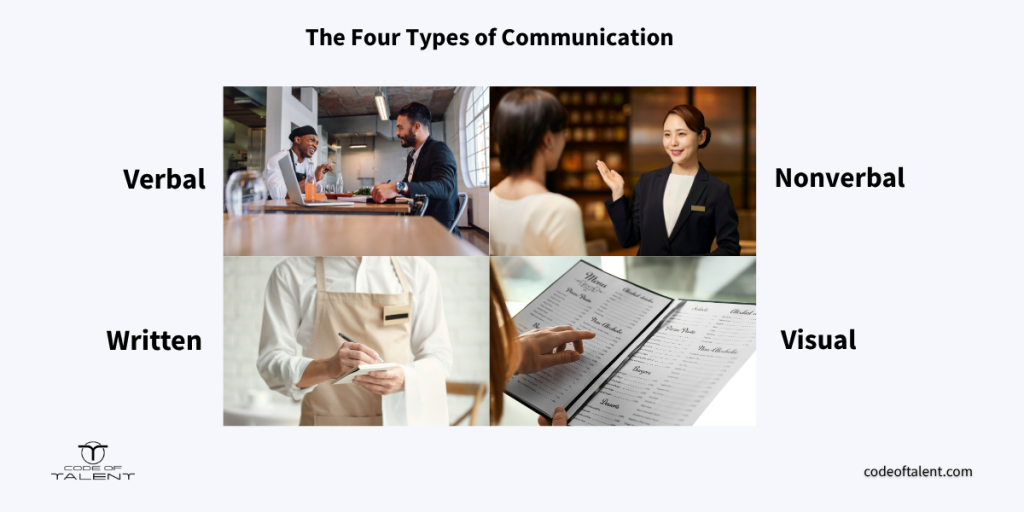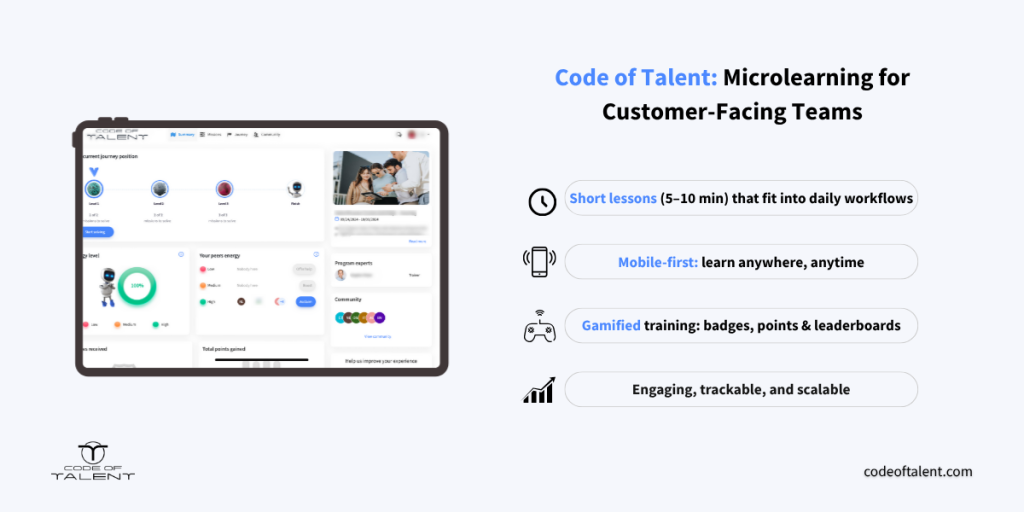Poor communication costs U.S. businesses an estimated $1.2 trillion annually and $12,506 per employee per year, according to the Grammarly Business 2023 Report. And in customer-facing industries, from hospitality to healthcare to retail, the cost of poor communication can spiral quickly. It reflects daily breakdowns in service, frustrated guests, and declining profit. That’s why communication skills training for employees has become an essential investment for businesses, especially those in customer-facing industries.
This article explores why communication skills training for employees is so important in customer service–focused businesses, the pitfalls of poor communication for both staff and the company, and best practices and effective methods to develop this essential soft skill.
The Four Types of Communication
No matter the medium or context of a conversation or message delivery, communication takes four forms:
- Verbal
- Nonverbal
- Written
- Visual

Knowing how to communicate is not just about speaking clearly but also about reading situations, using body language correctly, writing clearly and purposely, and presenting visual cues that support verbal exchanges.
As for customer-facing professionals, they rely on multiple channels of communication, often switching between them rapidly in a single shift. Here’s how each form plays a vital role in customer service environments.
Verbal Communication
Words matter. But in fast-paced, high-pressure environments like restaurants or front desks, how something is said often matters just as much as what is said.
Importance
Verbal communication allows employees to resolve issues quickly, provide clear answers, and reassure guests who may be stressed, confused, or upset. It builds confidence, both for the guest and the employee. In high-stakes moments, such as dealing with an allergy concern or an overbooked reservation, clear verbal exchanges can prevent crises.
Communication Styles
People communicate in different ways depending on their personality, character, motives, and the situation. To communicate better, it helps to recognize and understand each communication style so responses can fit the moment. And this also applies to building a comprehensive communication skills training for employees program.
Researchers in communication and psychology divide these styles into four main categories:
- The passive style avoids conflict and often comes across as uncertain or uninterested.
- The aggressive style expresses opinions strongly, which can alienate or offend guests.
- The passive-aggressive style appears agreeable but undermines trust through sarcasm or avoidance.
- The assertive style is clear, respectful, and direct, making it the ideal approach for most customer-facing roles.
Nonverbal Communication
Sometimes, what isn’t said speaks louder than words.
Importance
Facial expressions, posture, eye contact, and gestures all convey tone, intent, and professionalism. Moreover, according to a study, nonverbal communication includes much more than these. It also expresses:
- Status
- Power
- Emotion
- Leadership
- Deception.
A well-trained employee understands how to use these nonverbal signals to build trust, show empathy, or signal urgency. Even uniform presentation matters: a neatly dressed server with an open posture communicates professionalism and care.
Additionally, in tense situations, nonverbal communication often serves as the first line of defense. A calm expression or a simple nod can help defuse a potentially negative guest encounter before words are even spoken.
Written Communication
From text confirmations to shift notes, written messages play a bigger role in service operations than most people realize.
Importance
An unclear note, a mistyped menu item, or a rushed email can lead to real-world mistakes. Written communication should be concise, accurate, and aligned with the company’s tone and values. Employees who write guest-facing content need to be trained to adjust tone depending on the situation, especially when replying to complaints or sensitive feedback.
Internally, shift updates, scheduling changes, and performance reviews all rely on effective written communication.
Visual Communication
In the rush of service, visuals often do the talking, as humans tend to remember pictures better than words, according to research.
This is explained by the dual coding theory, which says our brains have two separate but connected systems: one for verbal information and one for images. While words mainly activate the verbal system, pictures engage both systems, making visual information easier to recall and understand.
Importance
Whether it’s allergen icons on a menu, digital signage at a check-in counter, or the layout of a dashboard, visual communication helps guests process information quickly.
On the flip side, poor design can:
- Confuse: A lack of contrast in signs might make allergy warnings unreadable.
- Mislead: Overly complex visuals can delay decisions and lead to mistakes
- Frustrate: Customers can feel frustrated when photos on menus don’t match the actual food served.
The High Stakes of Poor Communication in Customer-Facing Work
Communication issues in customer service-focused industries don’t just stay behind the scenes. They show up in complaints, poor reviews, and staff frustration.
Conflict and Misunderstanding in the Workplace
A missed message or a misread tone can create serious tension. In customer service, these communication gaps often lead to:
- Public confrontations with guests
- Friction between teams behind the scenes
Cultural and language differences can make these problems worse, especially in diverse workplaces. When floor staff misunderstand kitchen notes, or housekeeping misreads guest requests, both the guest experience and the brand reputation suffer.
The Ripple Effect on Productivity and Morale
Poor communication also impacts employees on a personal level and slows everything down. Teams might:
- Do the same task twice
- Miss important duties
- Make guests wait longer
Frustration grows when employees don’t feel heard or clear about what’s expected of them. Over time, low morale leads to more staff quitting, increasing turnover.
Real-World Impact: Fines and Reputational Damage
For the business, poor communication can lead to more than just a few 1-star reviews on Google. Sometimes, they escalate to fines and irreversible reputational damage, all thanks to the power of online reviews, social media reach, and customer’s evergrowing demands.
A clear example is a 2024 incident that happened at Cracker Barrel in Maryland. A group of students with special needs had a planned meal, but staff, unaware of the arrangements, refused to serve them.
Restaurant representatives said the event resulted from internal miscommunication and mismanagement. The incident led to firings, company-wide retraining, and damaged public trust, along with a media backlash.
The Urgent Need for Tailored Communication Skills Training for Employees
In client-facing businesses, developing employees’ soft skills should be a top priority because these businesses rely heavily on customers’ opinions of the service.
Communication skills, in particular, must be a key part of training for customer service roles, starting right from onboarding. Here’s why.
Accommodating New Generations
Client-facing jobs, especially in hospitality and retail, often have many young employees. However, many new hires, especially Gen Z, have spent formative years learning remotely due to the COVID-19 pandemic. Because of this, in-person interactions can feel challenging for them.
Hospitality-Specific Needs
In hotels, restaurants, and cafes, speed and emotion run high. Communication must be fast, calm, and effective. This includes:
- Handling dietary restrictions or sensitive feedback.
- Relaying orders and changes between floor and kitchen.
- Understanding accents, nonverbal cues, and cultural norms.
Multicultural Businesses
Many customer-facing industries, especially hospitality and retail, employ a diverse workforce made up largely of immigrants and foreign-born workers. This diversity brings rich cultural perspectives but also unique communication challenges.
Language barriers, different cultural norms, and varying levels of familiarity with local customs can make clear communication harder.
How to Implement an Effective Communication Skills Training for Employees Program
Training works best when it fits the real pace and demands of daily work. Customer-facing roles are often fast and unpredictable, with short breaks and many different tasks. That means communication training has to be practical, focused, and flexible.
1. Identify What Needs to Be Changed/Improved
Start by listening to the people on the frontlines, as they know best where communication breaks down.
- Are orders getting mixed up?
- Do messages get lost during shift changes?
Use surveys, team talks, or even quick interviews to identify the biggest problems. This insight helps shape training that targets real issues, not just theory.
2. Tailor Training for Frontline Contexts
The best training is relevant. Teaching general communication won’t help much if it doesn’t fit the workplace. Focus on key areas like:
- Resolving conflicts with guests calmly
- Using the right words for hospitality
- Handling communication across languages and cultures.
3. Choose the Right Training Delivery Method: Go Micro for More
For customer-facing roles, going micro is the best option for training. Gone are the days of long, irrelevant training that only happened during onboarding or once a year because policy required it. With microlearning, training customer-facing employees is both practical and engaging.
What is Microlearning?
Microlearning means delivering short, focused lessons of 5 to 10 minutes that can fit into breaks or slow moments. Microlearning platforms are available on both desktop and mobile devices, so they can be accessed anytime and anywhere, which is a perfect alternative for the busy schedules of client-facing employees.
It’s flexible, practical, and far more engaging than traditional formats. Better yet, employees can move at their own pace, with no pressure or rigid deadlines.
Gamify Training
For younger employees, microlearning is a better option as most microlearning platforms also incorporate gamification, making training feel more interactive, rewarding, and familiar, like the apps and games they already use daily. Leaderboards, journey maps, badges, icons, and points are some of the features that make gamification a pioneer of engaging training content.
4. Diversify the Training Formats
Not everyone learns the same way. Some absorb best by watching, others by doing. That’s why effective communication skills training for employees should go beyond reading manuals or watching long lectures. The more engaging and varied the format, the better the learning sticks, especially in client-facing roles.
Here’s how to mix things up and make communication training more effective:
- Role-Playing Exercises: Nothing prepares employees better than practicing real-life scenarios. Role-playing gives them a chance to navigate tough conversations, like handling a frustrated guest or resolving a team conflict, before they happen on the job.
- Reflections and Self-Assessments: Encourage employees to pause and reflect: What went well in that last interaction? What could have been clearer? A quick journal prompt or guided reflection after a shift can lead to long-term improvement and self-awareness. It also helps in improving written communication abilities.
- Short Quizzes: Fast quizzes help reinforce key points, like communication styles, active listening tips, or how to handle cultural misunderstandings. They’re also a great way to track learning progress without overwhelming the team. For foreign employees, short quizzes are the best way to learn a new language and cultural differences.
- Short Videos: Engaging videos, especially those featuring real guest scenarios, make abstract ideas like tone, posture, or empathy easier to understand. They’re perfect for visual learners and can be revisited anytime for a quick refresher.
5. Measuring Progress and Impact
Tracking improvement shows whether your communication training is actually making a difference. The right data helps you understand what’s working and what needs work.
Use tools like:
- Guest feedback and reviews
- Mystery shopper reports
- Staff self-assessments and surveys
- Manager observations during shifts
Look for patterns of improvement in key behaviors, like quicker responses, friendlier tones, and smoother conflict resolution. These behaviors are directly tied to measurable results.
Key customer service and training KPIs to track:
- Guest satisfaction scores (CSAT): A higher CSAT score often signals improved communication and service quality.
- Net Promoter Score (NPS): Measures how likely guests are to recommend your business—closely linked to service experience.
- Response time to guest inquiries or issues: Shorter response times usually indicate better internal communication and confidence.
- First-contact resolution rate: How often issues are resolved in the first interaction, an indicator of clarity and listening skills.
- Training completion and engagement rates: Especially useful for microlearning or scenario-based formats.
- Employee turnover or exit feedback: Poor communication often plays a hidden role in staff dissatisfaction.
Regular check-ins and pulse surveys help reinforce training and catch problems early. The goal isn’t perfection but consistent growth and awareness.
6. Sustaining a Culture of Communication
Training doesn’t stop after onboarding. Great communication becomes a habit when it’s part of the workplace culture every day, every shift.
Lead by Example
Managers and team leads set the tone. When leaders model clear, respectful, and open communication, employees follow suit. This includes how they give feedback, handle complaints, motivate their team, and talk to one another under pressure.
Build It Into the Routine
- Start team meetings with a quick refresher tip or role-play.
- Use real-life guest interactions (good or bad) as learning moments.
- Share shoutouts for excellent communication—peer recognition goes a long way.
Make Communication Part of Performance
- Include communication skills in performance reviews and promotions.
- Reward not just speed or sales, but how well someone handles a tough guest or collaborates with teammates.
Keep Feedback Loops Open
- Ask employees regularly: What’s confusing? What would make it easier to communicate?
- Collect feedback after big events or busy seasons to improve processes.
- Let staff suggest improvements to tools, signage, or handoff procedures.
Normalize Continuous Learning
Offer optional refreshers, language support, and even short modules on conflict resolution or active listening. Keep resources accessible: on tablets, phones, or bulletin boards in staff areas.
A Platform Designed for Customer-Facing Needs
Code of Talent is purpose-built for industries where communication, speed, and customer experience are everything. That’s why it’s a perfect fit for customer-facing environments like hospitality, retail, and food service.
The platform goes beyond just soft skills. It helps frontline teams master:
- Clear and effective communication skills
- Company-specific policies and brand standards
- Guest experience optimization
- Safety protocols and risk management
- Accelerated onboarding for new hires
Because it’s mobile-first and microlearning-based, training fits into real schedules in short, just-in-time sessions that staff can access on the floor or between shifts. It’s also easily scalable, whether you’re running one café or a global hotel chain.
Trusted by major customer-facing brands like Coca-Cola, Vodafone, Penny, and AstraZeneca, Code of Talent helps businesses deliver consistent, high-quality service across all locations.
See how Coca-Cola used Code of Talent to elevate its customer experience here.

In Conclusion
Great communication isn’t about sounding polished. It’s about connecting with people in a way that feels clear, respectful, and human. That takes training.
Whether it’s resolving a guest issue, coordinating during a rush, or replying to a review, communication skills training for employees helps build stronger teams, happier customers, and better business outcomes. Try Code of Talent’s free trial today and create a custom communication training program from scratch, made for the realities of the modern frontline.
FAQ
What is communication skills training?
It’s teaching employees how to speak clearly, listen well, and adapt their style to different situations—vital for customer-facing roles.
Why is it important in hospitality and retail?
Good communication prevents errors, resolves conflicts, and keeps guests happy in fast-paced environments.
How often should training happen?
Regularly, not just at onboarding. Short, ongoing sessions help keep skills fresh and practical.
How do you train a multicultural team?
Use videos, role-plays, and multilingual tools to make training clear and inclusive.
How do you measure success?
Track guest satisfaction, response times, resolution rates, and employee feedback.
What’s the best training platform?
Code of Talent is ideal for frontline teams—mobile-friendly, engaging, and scalable—perfect for effective communication skills training for employees.
Cover photo: Freepik





